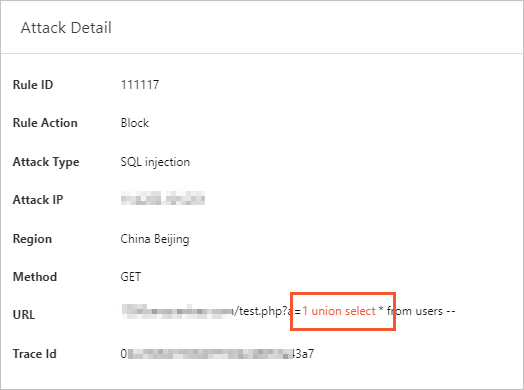This topic describes best practices for the protection rules engine provided by Web Application Firewall (WAF).
Scenarios
WAF protects your website against web attacks, such as SQL injections, XSS attacks, remote code executions, and webshell attacks. For more information about web attacks, see Definitions of common web vulnerabilities.
Configure protection policies
By default, Protection Rules Engine is enabled and Protection Rule Group is set to Medium rule group after you add your website to WAF. This blocks common attacks. You can go to the Website Protection page to view the status of Protection Rules Engine and configure protection policies. For more information, see Configure the protection rules engine.
- Status: Turn on or off the switch to enable or disable the protection rules engine. This engine is enabled by default.
- Mode: Select the action that you want WAF to take on requests when WAF detects attacks.
Valid values:
- Block: WAF automatically blocks requests and logs attacks in the backend.
- Warn: WAF does not block requests but logs attacks in the backend.
- Protection Rule Group: Select a group of protection rules that you want to apply. Valid values:
- Medium rule group: blocks common web application attacks in a standard way. These attacks can bypass protection policies.
- Strict rule group: blocks web application attacks in a strict way. These attacks can bypass complex protection policies.
- Loose rule group: blocks common web application attacks.
Note These settings take effect only when you enable the protection rules engine.If you use WAF Business or Enterprise in the Chinese mainland or WAF Enterprise outside the Chinese mainland, you can customize protection rule groups. The custom rule groups combine all protection rules provided by WAF and provide specific protection policies for your website. For more information, see Customize protection rule groups.
- If you are not clear about the characteristics of your business traffic, we recommend
that you set Mode to Warn. After one or two weeks, analyze the attack logs in this mode.
- If the attack logs show that normal traffic is not blocked, you can set Mode to Block.
- If the attack logs show that normal traffic is blocked, you can contact Alibaba Cloud security experts to resolve the issue.
- If you add phpMyAdmin and development technology forums to WAF for protection, WAF may block normal traffic. If this occurs, we recommend that you contact Alibaba Cloud security experts to resolve the issue.
- We recommend that you take note of the following points:
- Do not pass raw SQL statements or JavaScript code in the HTTP requests for your normal business.
- Do not use special keywords, such as UPDATE or SET, in the paths for normal business
URLs. For example, do not use
www.example.com/abc/update/mod.php?set=1. - Do not use a browser to upload files that exceed 50 MB. We recommend that you upload the files by using OSS or other methods. For more information, see Get started with OSS.
View protection effects
After you enable the protection rules engine, you can view its protection records. To view the records, click Security report. On the page that appears, click Web Security and view the report on the Web Intrusion Prevention tab. For more information, see View security reports.

View rule updates
WAF updates protection rules and releases protection bulletins in a timely manner to fix known and zero-day vulnerabilities. To view Rule updates notice, go to the Product Information page. For more information, see View service information.